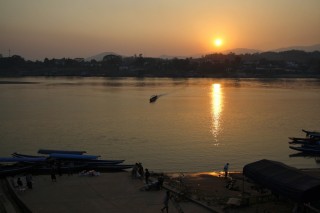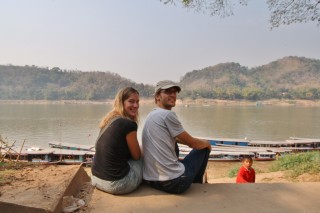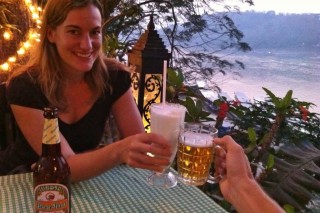 Even though Laos is really just across the river from Thailand, we stepped out into a very different country after we had crossed the Mekong in a small wooden boat. Our first hour in Laos was spent filling our arrival cards, paying visa fees, waiting, signing here, signing there, waiting some more, and eventually paying even more with the hint to a sign the officers put up: ‚4-6pm 1$ overtime fee‘. Notably the border crossing is officially open until 6pm, but this corruption fee apparently goes by other names at different times of the day, such as ‚just started working fee‘, ‚digesting my lunch fee‘ etc. By the time they finally glued the Laos visa into our passports, we had watched the first of many sunsets to come over the Mekong – a beautiful sight, and this mighty river would accompany us for the next few weeks. Because of the very mountaineous terrain and the fact that the downpours during the rainy season cause landslides and make many roads impassable, the river remains the main transport link in the North. Nevertheless, we chose to make our way south by bus – in the dry season a feasible alternative to an overpriced two day boat trip on the wooden benches of the Mekong boats. Funnily enough, this meant going in the opposite direction first. Why? Because the only real road here is built by the Chinese, who wanted to connect China with Thailand for ease of trading. So the bus made its way through the mountains for hours on a nice new highway towards the Chinese border in the North, before finally turning in the right direction and bumping along on unsealed dirt road for the rest of the night. I couldn’t really sleep, so I looked out into the dark. There was no light whatsoever, just the headlights of the bus, and the stars that kept turning above as the bus wound its way up and down the mountains. The journey reminded me of an overnight bus ride we took a few years ago in Bolivia (I am sure my brother and sister remember that one too!) where the bus got stuck in some sandholes on dirt roads in the middle of nowhere, everything pitch black all around us. The concept of having long-distance bus routes but no proper roads connecting the departure and arrival point seems no contradiction in some countries.
Even though Laos is really just across the river from Thailand, we stepped out into a very different country after we had crossed the Mekong in a small wooden boat. Our first hour in Laos was spent filling our arrival cards, paying visa fees, waiting, signing here, signing there, waiting some more, and eventually paying even more with the hint to a sign the officers put up: ‚4-6pm 1$ overtime fee‘. Notably the border crossing is officially open until 6pm, but this corruption fee apparently goes by other names at different times of the day, such as ‚just started working fee‘, ‚digesting my lunch fee‘ etc. By the time they finally glued the Laos visa into our passports, we had watched the first of many sunsets to come over the Mekong – a beautiful sight, and this mighty river would accompany us for the next few weeks. Because of the very mountaineous terrain and the fact that the downpours during the rainy season cause landslides and make many roads impassable, the river remains the main transport link in the North. Nevertheless, we chose to make our way south by bus – in the dry season a feasible alternative to an overpriced two day boat trip on the wooden benches of the Mekong boats. Funnily enough, this meant going in the opposite direction first. Why? Because the only real road here is built by the Chinese, who wanted to connect China with Thailand for ease of trading. So the bus made its way through the mountains for hours on a nice new highway towards the Chinese border in the North, before finally turning in the right direction and bumping along on unsealed dirt road for the rest of the night. I couldn’t really sleep, so I looked out into the dark. There was no light whatsoever, just the headlights of the bus, and the stars that kept turning above as the bus wound its way up and down the mountains. The journey reminded me of an overnight bus ride we took a few years ago in Bolivia (I am sure my brother and sister remember that one too!) where the bus got stuck in some sandholes on dirt roads in the middle of nowhere, everything pitch black all around us. The concept of having long-distance bus routes but no proper roads connecting the departure and arrival point seems no contradiction in some countries.
In the morning we finally arrived in Luang Prabang. These days, the former royal capital of Laos is a charming small town packed with loads of atmospheric temples and of course the royal palace. During the French protectorate, this impressive building was the seat of the figurehead Lao ruler, and also the home of the king of Laos after Laos became independent (1953-1975). The kingdom’s end came when the communists took over the country and established the Lao People’s Democratic Republic which exists to this day.
Monks in their orange robes are just as numerous as the tourists in the streets of the city. We loved wandering into random temples, sometimes bumping into young monks that spoke English really well (like we already encountered in Chiang Mai) and who answered our curious questions about why they chose to become monks at such a young age, and what life as a monk is like. Interestingly, we heard more than once from these young temple inhabitants that as a monk, they receive education at the monastery and are entitled to study certain subjects for free at the university, which in a poor country like Laos is a major drawcard. Not all will stay in the monastery forever though – many also leave after a few years and return to a secular life. Monastic traditions however are alive and well in Luang Prabang. Every morning, monks flood the streets to collect food that the citizens donate to them, in exchange for blessings from the monks. A few times we just sat quietly and barefoot in the back of a temple and listened to their chanting sessions in the evening. I think you don’t have to be religious to find a certain calmness in such moments.
We were somewhat surprised to see how the French legacy still pervades everyday life. Bilingual signs were often in Lao and French instead of English, and the probably most French thing of all were the baguettes that were sold everywhere and appear to be an integral part of the Lao diet. They were actually really good – fresh crispy bread is not something you get everyday in Asia. So while nibbling on some tastily filled baguettes, we slowly got acquainted with this new country on our itinerary and settled into the relaxed pace that life has here. We loved just sitting on the banks of the Mekong, in the shade of coconut and banana trees, watching the boats go by, and contemplating where to go next – once we were done with just enjoying the fantastic atmosphere in Luang Prabang.







